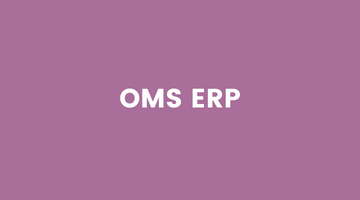OMS ERP

What is ERP ?
An ERP is a business resource planning system used to plan a company’s core business, such as production, logistics and finance etc. The acronym ERP refers to a system or software package used by an organization to manage the day-to-day operations of their business such as project management, product management, manufacturing, procurement, sales and accounting. An ERP system is the backbone of a company because it manages the processes and assets of different departments that are static and unlikely to change (such as purchasing cycle, store locations, accounting functions, etc.).
What is OMS ERP ?
OMS ERP is a dedicated order management system and that can serve as a single source of truth for the order and fulfillment data while remaining agnostic, integrated and communicating with all other critical systems. An OMS automates the entire order management process for your company and takes over all functions associated with the fulfillment of customer orders. It helps your employees and customers view and track orders from start to finish and helps you measure the overall efficiency of the entire process.
The right system can deliver real-time data on orders, inventories, customers and more. This is the kind of information you need for intelligent analysis and decision-making. An additional ERP ensures that information enters the system and transmits the necessary information to customers, suppliers and employees when needed, without having to use multiple screens, which can be time-consuming.
As one of the sales platforms for your website, the most important integration you need to create for your website is your OMS, which is the channel for your inventory and fulfillment processes into CRM, billing and other systems. You want your OM to be the central place where you process and track your orders. An Order Management System is implemented and integrated in your order entry and processing as well as your inventory processes predictably to be successful.
Purchasing and managing orders is not advisable for small businesses. Without a robust order management system (OMS) it takes longer and deploys IT resources from the whole team to ensure the reliability of the ERP used to manage orders. In order to increase the agility of the day-to-day business without negatively affecting the accounting and financial processes, you need to create an effective symbiosis between ERP and the order management system.
In retail, large retailers use OMS to track customer orders, inventory, maintenance, packaging, shipping and order synchronization across multiple channels, such as: OMS-specific functionalities for order management can be retrofitted to an ERP.
Order management systems are also referred to as financial market trading because they are used on both the buyer and the sales side, although the functionalities provided by the two sides of the OMS differ. Companies can purchase OMS software in individual modules that cover different aspects of order management, or in a complete suite that manages the entire process.
Nevertheless, an OMS is a complement to an ERP that treats e-commerce and retail needs as a universal system that feeds logistics and account information into the ERP. Adding a dedicated OMS gives you a more detailed view of customers and order processing that an ERP cannot provide. Adding OMS to your existing ERP adds agility and granularity to your customer interactions.
At this point, your online business is ready for an Order Management System (OMS) software system (Order Management System), software that helps you centralize your ordering processes across sales channels and fulfillment methods. An OMS is the brain of your sales process and coordinates all functions of your customer-oriented channels across your backend systems, from ERP to Business Intelligence (BI) tools. OMS not only supports all phases of your company’s sales process, from order creation to customer delivery, but also enables you to quickly address the logistical challenges inherent in the omnichannel world.
An order management system (OMS) or software that helps you centralize order processing across sales channels and fulfillment methods, automates your workflow and helps you manage your customer experience. The right system can also make warehouse management, logistics and more processes more intuitive.
As ERP continues to expand, many retailers are leveraging the functionality of their ERP systems to manage all but one aspect of their sales and marketing processes.
Department heads are tasked with learning the new platform and working on mastery of individual functions, data stores and reporting tools. Because they can handle other implementations, ERPs can replace many other systems that have changed processes, such as call centers, warehousing, inventory control, and accounting. Before introducing a new ERP or OM system, companies must evaluate the capabilities of end users and IT departments that may have different needs from those supported by legacy systems.
The inclusion of new fulfillment processes in an ERP system means that new functionalities have to be implemented, which can be expensive and slow to implement. Even if your employees get it right, the process of ordering and updating the system will take some time.
ERP systems do not have to cover all the functionality of the company for which they are designed, but they should be designed in such a way that they can control broad and specific processes.
